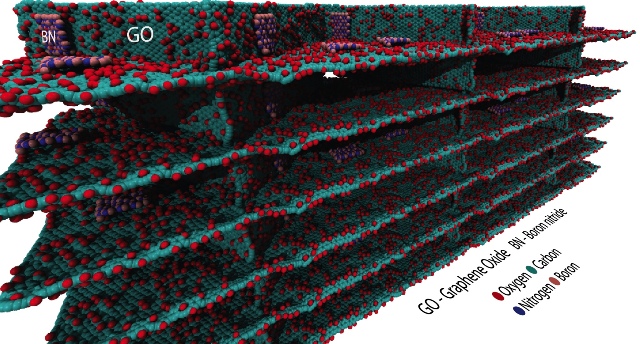Jul 30 2014
Tough, ultralight foam of atom-thick sheets can be made to any size and shape through a chemical process invented at Rice University.
In microscopic images, the foam dubbed “GO-0.5BN” looks like a nanoscale building, with floors and walls that reinforce each other. The structure consists of a pair of two-dimensional materials: floors and walls of graphene oxide that self-assemble with the assistance of hexagonal boron nitride platelets.
 An illustration shows sheets of graphene oxide that self-assemble into the floors and walls of structured foam with help from platelets of hexagonal boron nitride that bind the sheets together. The tough, ultralight foam was created by materials scientists at Rice University. Click for a larger version. Illustration by Pedro Alves da Silva Autreto
An illustration shows sheets of graphene oxide that self-assemble into the floors and walls of structured foam with help from platelets of hexagonal boron nitride that bind the sheets together. The tough, ultralight foam was created by materials scientists at Rice University. Click for a larger version. Illustration by Pedro Alves da Silva Autreto
The researchers say the foam could find use in structural components, as supercapacitor and battery electrodes and for gas absorption, among other applications.
The research by an international collaboration led by the Rice lab of materials scientist Pulickel Ajayan is detailed in the online journal Nature Communications.
Graphene oxide (GO) is a variant of graphene, the hexagonal lattice of carbon atoms known for its superior strength and conductivity. It can be produced in bulk by chemically exfoliating oxidized graphite. Hexagonal boron nitride (h-BN) looks like GO, with the same “chicken wire” array of atoms. An insulator known as “white graphene,” h-BN has an ability to form seamless interfaces with graphene that has led to the creation of interesting hybrid materials at Rice and elsewhere.
Soumya Vinod, the Rice graduate student who co-led the project, said she and her colleagues expected adding h-BN to graphene oxide would toughen the resulting foam, but “the ordered, layered structure was not entirely expected.”
“Once we observed the structure, we knew it was very different from the other nanoengineered foams reported and could lead to very interesting properties,” she said.
Those properties include the ability to handle a great deal of strain and still bounce back to its native form. This is remarkable, Vinod said, for a material so light that a stray breath in the lab would send the small samples flying.
Both components of the new material start as cheap, plentiful powders. Atom-thick layers of graphene oxide and h-BN are chemically exfoliated from the powders, mixed in the proper proportion with a few chemical catalysts and freeze-dried. The resulting foam takes the shape of the container and is 400 times less dense than graphite.
For testing, Vinod and her colleagues made foams of pure graphene oxide and foams with h-BN at 25 and 50 percent by weight. The 50 percent h-BN version was found to be the most mechanically stable, though she expects to optimize the mix — and increase the size — with further experimentation. “We found that more concentration of h-BN leads to low structural integrity, but we’ve yet to optimize the right amount,” she said.
A close-up look at the foam revealed the floors as self-assembled sheets of overlapping GO flakes. Cross-linking platelets of h-BN were uniformly distributed throughout the material and held the sheets together.
Samples the size of a pencil’s eraser were compressed with one or two pennies to see how well they would bounce back.
The h-BN platelets connect to graphene oxide and absorb stress from compression and stretching, preventing the GO floors from crumbling and significantly enhancing the material’s thermal stability, Vinod said. The platelets also prevented the propagation of cracks that destroyed samples with less or no h-BN.
Chandra Sekhar Tiwary, a graduate student at the Indian Institute of Science, Bangalore, with a complimentary appointment at Rice, is co-lead author of the paper. Co-authors include Pedro Alves da Silva Autreto, a researcher at the State University of Campinas, São Paulo, with a complimentary appointment at Rice; Rice alumnus Jaime Taha-Tijerina, a researcher at Carbon Sponge Solutions in Houston and at Viakable Technology and Research Center in Monterrey, Mexico; Rice graduate students Sehmus Ozden and Alin Cristian Chipara; Rice senior faculty fellow Robert Vajtai; Douglas Galvao, a professor at the University of Campinas; and Rice alumnus Tharangattu Narayanan, a scientist at the Central Electrochemical Research Institute, Karaikudi, India. Ajayan is Rice’s Benjamin M. and Mary Greenwood Anderson Professor in Engineering, professor of materials science and nanoengineering and of chemistry, and chair of the Department of Materials Science and NanoEngineering.
The U.S. Air Force Office of Scientific Research through a Multidisciplinary University Research Grant, the National Science Foundation (NSF) through the Early Concept Grants for Exploratory Research competition and the Indo-U.S. Science and Technology Forum supported the research. The researchers utilized the NSF-supported Data Analysis and Visualization Cyberinfrastructure (DAVinCI) supercomputer and the BlueBioU supercomputer, both administered by Rice’s Ken Kennedy Institute for Information Technology.